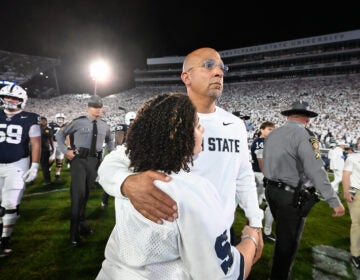A month after rejecting an earlier proposal, Penn State trustees agree to WHYY’s takeover of school’s public media station
The university will no longer be required to pay a $17.6 million subsidy to WHYY as financial supporters are expected to step up to save the central Pennsylvania station.
Listen 1:25
This is the Penn State logo on the side of a Penn State merchandise trailer outside Beaver Stadium on Friday, Sept. 5, 2014 in State College, Pa. (AP Photo/Gene J. Puskar)
From Philly and the Pa. suburbs to South Jersey and Delaware, what would you like WHYY News to cover? Let us know!
In a unanimous vote Monday, the Penn State Board of Trustees approved key terms to transfer control of WPSU — the university’s public radio and television station — to WHYY, the public media organization based in Philadelphia. The deal, which comes one month after trustees rejected an earlier proposal, could keep WPSU on the air after warnings it might otherwise shut down by 2026.
In last month’s vote, trustees turned down a proposed agreement with different terms. During that debate, some trustees expressed concern over a $17.6 million university subsidy to support the transfer to be paid over the course of five years without a guarantee that WHYY would continue to operate the station beyond that. They also cited what they said was an insufficient commitment by WHYY to retain WPSU staff.
After that vote, university officials announced plans to shutter WPSU by June 2026. The announcement sparked public outcry, including a change.org petition signed by more than 20,000 people.
Board Chairman David Kleppinger said the university received more than 1,300 public comments and emails regarding WPSU, along with personal messages.
“I do want to acknowledge the deep passion and concern that’s reflected in those messages,” Kleppinger said. “The overwhelming majority urged the university to reconsider the decision to wind down WPSU’s operations or to move forward with a sale that would allow the station to continue under public broadcasting organizations.”
PSU officials said the revised framework strikes a balance between the university’s financial realities and its commitment to maintaining access to public media across the region.
“At times, financial negotiations can necessitate multiple rounds of negotiation,” Sara Thorndike, Penn State’s senior vice president for finance and business and university treasurer, said in a statement. “We’re pleased this plan allows us to preserve the service WPSU provides while remaining fiscally responsible.”
Emily Reddy, news director at WPSU-FM, said her team was “happy that it looks like public media is going to exist in central Pennsylvania.”
“I know there are some hurdles that have to be jumped but this seems like a really positive outcome,” she said.
The new proposed transition includes commitments for WHYY to operate WPSU for at least three years after the transfer and to offer existing WPSU employees the opportunity to apply for comparable positions. Penn State also plans to transfer endowments and gifts designated for WPSU to WHYY.
Under the new deal, Penn State will not be required to provide additional subsidy funds as previously negotiated. Rather, WHYY will first secure at least $8.36 million in outside financing. WHYY President and CEO Bill Marrazzo said that effort is already well underway and that PSU alumni are making contributions.
Marrazzo also praised the trustees’ vote as an important step toward preserving local public broadcasting and news for the region.
“Your stories, your communities, and your voices remain at the heart of this work,” he said. “This is an investment in collaboration that will strengthen educational programming and local journalism for years to come.”
WPSU, which serves a 24-county region through radio and television broadcasts, has long operated at a deficit. In recent years, the university has subsidized the stations by more than $3 million annually. However, that has become a strain on the university as Penn State faces flat state funding, declining enrollment and a new budget model that prioritizes controlling tuition costs.
The issue was further exacerbated by Washington’s elimination of the Corporation for Public Broadcasting and the federal funding that helped support stations like WPSU and WHYY. After the trustees rejected the earlier proposal, WPSU became the first public media organization slated to close as a result of those cuts.
Marrazzo called the merger a win-win for WHYY as well as public media consumers in central Pennsylvania.
“We accept the fact that we are operating in a seriously competitive media environment,” he said. “If you accept the premise that I believe in, that WHYY is in the business of positively impacting people who want to be engaged through public media more deeply in their community, you’ve got to reach more and more people over time.”
WPSU has been part of Penn State’s identity for more than seven decades. WPSU-FM, an NPR affiliate, first went on the air in 1953 and now reaches roughly 450,000 listeners across 13 counties. Its television counterpart, WPSU-TV, a PBS affiliate, began broadcasting in 1965 and serves more than half a million households. Together, they provide local news, cultural programming and community engagement throughout the university’s home region.
Larry Terry, vice president for Penn State Outreach, said that he was pleased that central Pennsylvania residents would continue to have access to trusted public media.
“We have worked diligently to find the best path forward for the station, our people who work there, and certainly all of our WPSU viewers and listeners,” Terry said in a statement. “We are grateful that WHYY, one of the country’s leading public media organizations, recognizes the importance of maintaining access to public media for the Central Pennsylvania region and is committed to the continuation of these services in our communities.”
For decades, WPSU has served as both a media outlet and a training ground for Penn State students pursuing careers in journalism and communications. The station’s leadership has said that hundreds of students have gained hands-on experience through WPSU, many of whom went on to work in public radio, national newsrooms and local media across Pennsylvania.
“We are very pleased the stations will continue to offer our Bellisario College of Communications students real-world experiences,” Thorndike said.
The agreement now heads to WHYY’s board for consideration but must also be reviewed by the Federal Communications Commission for final approval, which Marrazzo said he is confident it will receive.
“It is a transaction that in many ways reinvents public media, and I would imagine that the FCC will look favorably on that,” he said.
If completed, the deal would give WHYY one of the largest public media footprints in the Mid-Atlantic — stretching from South Jersey and Delaware to western Pennsylvania.
As for WPSU, Reddy said she was grateful for the outpouring of support that helped save her station.
“We heard from a ton of people about public media and how much they appreciated WPSU and that was part of what is making this happen,” she said.

Get daily updates from WHYY News!
WHYY is your source for fact-based, in-depth journalism and information. As a nonprofit organization, we rely on financial support from readers like you. Please give today.




